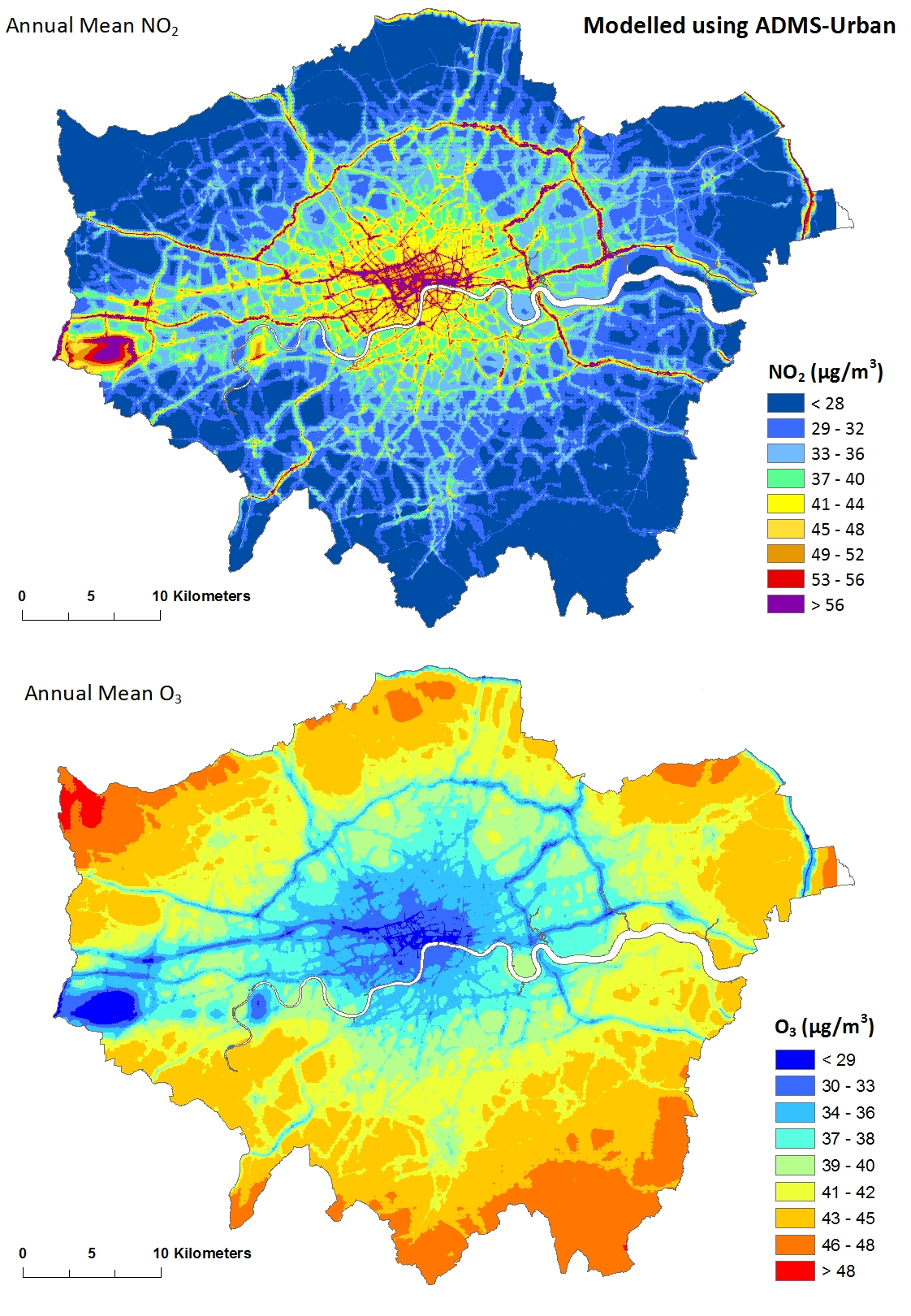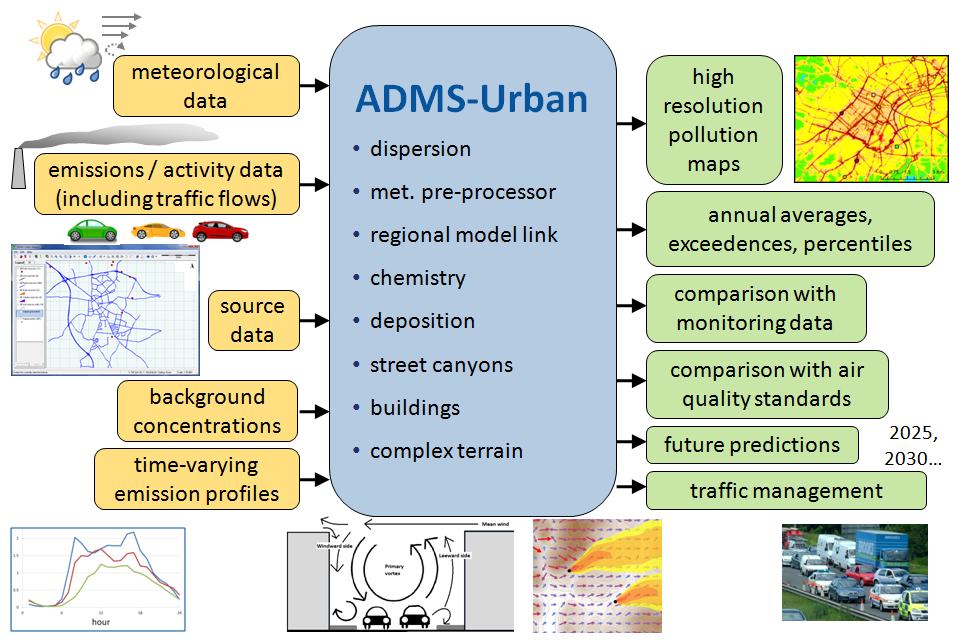Quoted from: http://www.cerc.co.uk/environmental-software/ADMS-Urban-model.html
What is ADMS-Urban?
ADMS-Urban is a comprehensive system for modelling air quality in large urban areas, cities and towns. It is the only practical urban air quality model which incorporates the latest scientific understanding, explicitly represents the full range of source types occurring in an urban area, takes account of complex urban morphology including street canyons, and provides output from street-scale to urban-scale and, with the regional model link, to even larger scales.

The proportion of total NOx concentration predicted by ADMS-Urban due to particular vehicle types at specific locations.
Typical applications include:
- assessment of modelled air quality against air quality standards and limit values including those from WHO, EU, UK, USA and China
- developing and testing policy and action plans for air quality improvement such as Clean Air Zones or Low Emission Zones
- investigation of air quality management options for the full range of source types including transport sources
- source apportionment studies
- air pollution exposure studies
- air quality and health impact assessments of proposed developments
- provision of detailed street-level air quality forecasts
Who uses ADMS-Urban?

Contour plot of London showing the annual average NO2 and O3 concentrations predicted by ADMS-Urban for 2008. NO2 regions shown in yellow, orange or red are predicted to exceed the UK NAQS targets.
ADMS-Urban is being used across the world for air quality management and assessment studies of complex situations in urban areas, cities, towns and close to motorways, roads and large industrial areas.
Users of ADMS-Urban include:
- Over 80 local authorities in the UK for their Review and Assessment of air quality under the Local Air Quality Management program and for developing air pollution action plans and remedial strategies.
- London, UK: air quality management studies for the UK Department of the Environment (Defra); emission compilation and modelling assessment of proposals for Heathrow Airport for the Department for Transport; airTEXT air quality forecasting system
- China: Beijing: planning the large-scale development for the 2008 Olympics, air quality forecasting; Shanghai: city planning, traffic sources; Hong Kong: city planning, traffic and airport sources; 5 cities in Liaoning Province: industrial, heating (coal burning) and area sources.
- Budapest, Hungary: decision-making and air quality forecasting, large industrial sources and traffic sources.
- Johannesburg, Cape Town, South Africa: air quality management
- Environmental Protection Agency of Lithuania: air quality maps of urban areas
- Strasbourg, France: air quality assessment and forecasting.
- Rome, Italy: real time traffic management or “now-casting”, traffic sources.
- Bologna, Italy: assessment of new tram system, traffic sources.
- California, USA: health impact assessment.
- Singapore: air quality management studies for National Environmental Agency
- Barcelona: air quality forecasting
Why use ADMS-Urban?
ADMS-Urban is distinctive in its ability to describe in detail what happens on a range of scales, from the street scale to the city-wide scale, taking into account the whole range of relevant emission sources: traffic, industrial, commercial, domestic and other less well-defined sources.
The science of ADMS-Urban is significantly more advanced than that of most other air dispersion models in that it incorporates the latest understanding of the boundary layer structure, using advanced algorithms for the height-dependence of wind speed, turbulence and stability to produce improved predictions. The model also takes account of the impacts of street canyons on dispersion, turbulence and mixing induced by traffic and includes a photochemical model for NOx and ozone.

This diagram shows some possible inputs to and outputs from the model, and some of the modelling options available.
Predicting pollutant concentrations from an urban area is a complex modelling problem. ADMS-Urban has been developed with a number of features to simplify the modelling process and help users. For example:
| Visualisation |
ADMS-Urban has links to ArcGIS and MapInfo Professional GIS (Geographical Information System) packages as well as Surfer contour plotting package. The GIS link can be used to enter and display input data and display output, usually as colour contour plots. |
| Emissions inventory |
Source and emissions data can be imported from a Microsoft Access database created by the user or exported from CERC's Emissions Inventory Toolkit, EMIT. EMIT contains current and future emission factors including those for vehicles, industrial processes and fuel consumption. |
| Emission factors |
Defra's Emission Factor Toolkit emission factors. |
| Intelligent gridding |
ADMS-Urban includes an intelligent gridding option which places extra output points in and adjacent to road sources to give excellent spatial resolution in areas of particular interest. |
| User-defined outputs |
The user defines the pollutant, the averaging time (which may be an annual average or a shorter period), any percentiles and exceedence values that are of interest, and whether or not a rolling average is required. The output options are designed to be flexible to cater for the variety of air quality limits which can vary from country to country and over time.
|
Modelling scenarios and future years[top]
In most cases, ADMS-Urban is first used to model the emissions from a base case scenario, that is, data (emissions, meteorology, background, etc.) are used to produce results that can be verified against locally monitored data from a recent previous year or the current year. Once the base case scenario has been validated, it is possible to investigate different scenarios, for example:
Impact of major development
ADMS-Urban is often used to compare air quality before and after major developments. An emissions inventory is compiled using the best available estimates for after the development. ADMS-Urban allows many What if? scenarios to be tried out, predicting concentrations at key receptors or across a wider area.
Future years
The majority of air quality limits are objectives for future years. These scenarios can be modelled in ADMS-Urban using Defra's Emission factor toolkit emission factors for future years, future predictions from EMIT or the user's own estimate. Likely changes in traffic flows, fleet compositions and background concentrations if known, can also be included in the future scenarios.
Traffic management
If the predictions for future years indicate that concentrations of certain pollutants are likely to exceed the objectives, it is usual to consider traffic management and emission reduction scenarios. For example, some local authorities in the UK are considering introducing Clean Air Zones or Low Emission Zones within which only vehicles that have achieved a particular low-emission standard are allowed. The effect on air quality of introducing such measures can be investigated using ADMS-Urban. CERC's Emissions Inventory Toolkit, EMIT can be used for investigating the effect on emissions.










